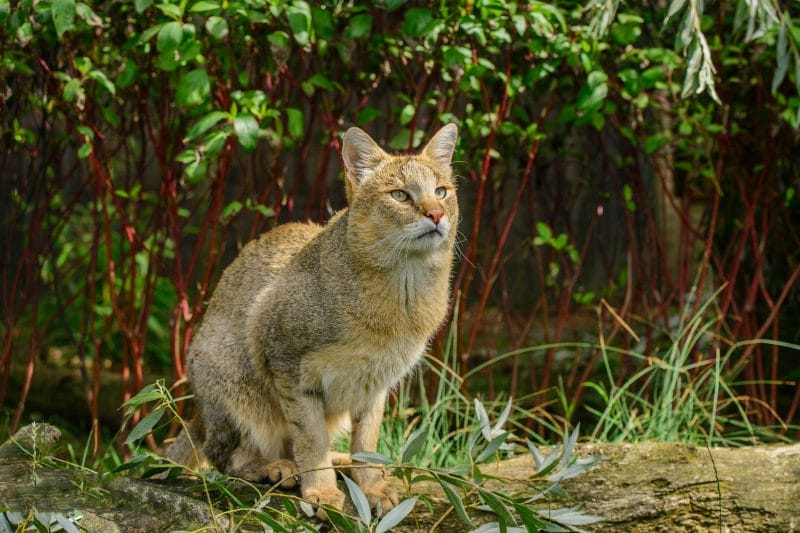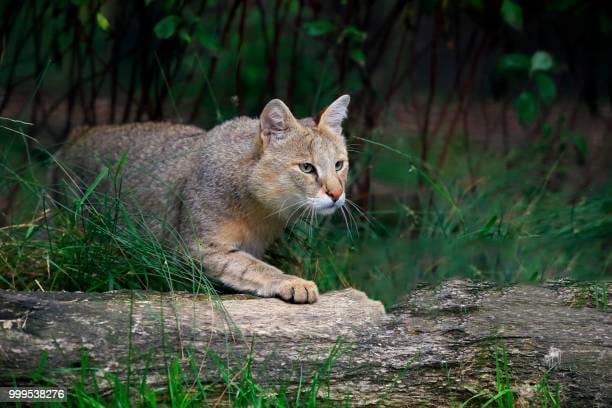The Jungle Cat, scientifically known as Felis chaus, is a captivating feline species with origins rooted in the vast landscapes of Asia and Africa. This medium-sized wild cat has an air of mystery and intrigue surrounding it. In this comprehensive guide, we will delve into everything you need to know about the enigmatic.
Jungle Cat Breed Overview
Affectionate with Family: ⭐⭐⭐
Amount of Shedding: ⭐⭐⭐
General Health: ⭐⭐⭐⭐
Potential for Playfulness: ⭐⭐⭐⭐
Tendency to Vocalize: ⭐⭐
Kid-Friendly: ⭐⭐
Friendly Toward Strangers: ⭐⭐
Easy to Groom: ⭐⭐⭐⭐
Intelligence: ⭐⭐⭐
Pet Friendly: ⭐⭐⭐
Jungle Cat at a Glance:
- Appearance: A sleek and slender body, typically sandy or grayish-brown fur with dark stripes and spots.
- Characteristics: Highly adaptable and skilled hunters with a solitary lifestyle.
- Popularity: Less well-known compared to domesticated breeds, but gaining interest among exotic cat enthusiasts.
- Temperament: Fiercely independent and elusive, they are not typically kept as pets.
- Lifespan: In the wild, they live up to 10 years, while in captivity, they can live slightly longer.
- Coat Color: Varies from sandy or grayish-brown with faint stripes and spots.
- Mixed or Original Breed?: An original wild species. While it has not been extensively bred with domestic cats, it is closely related to other wild cat species like the African wildcat, which can sometimes hybridize with domestic cats.

How to Take Care of a Jungle Cat
Food
Jungle Cats are wild by nature, and they have specific dietary requirements:
- A Natural Diet: In the wild, primarily hunt birds, rodents, and small mammals. In captivity, they require a diet that closely resembles their natural prey.
- Raw Diet: Many owners opt for a raw diet, which can include raw meat, organs, and bones. Consult with a veterinarian to ensure a balanced diet.
- Fresh Water: Always provide access to clean, fresh water.
Environment
Creating a suitable environment requires careful consideration of their wild instincts:
- Spacious Enclosure: If keeping in captivity, it should have access to a spacious, secure enclosure with climbing structures and hiding spots.
- Enrichment: Offer toys and puzzles that mimic hunting and foraging behaviors to keep their minds active.
- Privacy: Provide hiding spots and quiet areas where they can retreat to when needed.
Grooming
Proficient groomers themselves, but occasional brushing can help remove loose fur and prevent matting. Otherwise, they do not require extensive grooming.
Take Care Method
The primary focus in caring is to ensure they have a stimulating environment that mimics their natural habitat. Providing opportunities for hunting-like play with toys and regular interaction can keep them happy.
How to Buy/Adopt a Jungle Cat
Locations of Popularity
Jungle Cats are not typically kept as pets due to their wild nature. However, some exotic animal enthusiasts and wildlife rehabilitation centers may house them.
Average Price
Obtaining is highly regulated and, in many places, illegal. Additionally, the associated costs of maintaining a wild cat in captivity can be exorbitant due to specialized enclosures, permits, and veterinary care.
Adoption/Rescue Communities
Rescuing or adopting a Jungle Cat is rare due to the restrictions surrounding their ownership. It is crucial to adhere to local wildlife regulations and consult with authorities before attempting to rescue or adopt such a wild species.

What to Check Before Adoption/Purchase
If you are in a region where ownership is permitted, it is crucial to ensure the cat has the appropriate permits and was obtained legally. However, owning is not recommended for the average pet owner due to their wild nature.
How to Prepare for a Jungle Cat’s Life
Three Short Advice Sentences:
Ensure you have the legal right and capacity to own before considering it as a pet.
If you are a wildlife rehabilitator or involved in conservation efforts, seek expert guidance on caring for these animals.
If you encounter a Jungle Cat in the wild that appears injured or in distress, contact local wildlife authorities for assistance.
Essential Equipment:
- A secure and spacious enclosure with appropriate fencing.
- Toys and puzzles that mimic hunting and foraging behaviors.
- Access to clean, fresh water.
Common Diseases:
- Parasitic Infections: Regular deworming and preventative measures can help control parasites.
- Respiratory Infections: Ensure a clean and stress-free environment to prevent respiratory illnesses.
- External Parasites: Check for fleas, ticks, and mites regularly.
Necessary Vaccines:
Jungle Cats are not typically vaccinated like domestic cats. Their care primarily focuses on their overall well-being and preventing stress-related illnesses.
Common Names for Jungle Cats
Naming is not a common consideration, given their wild nature. However, if you find yourself caring for one in a wildlife rehabilitation or conservation setting, consider names that reflect their natural habitat, such as “Savannah” or “Wilderness.”

In conclusion, Jungle Cats are captivating wild creatures that thrive in their natural habitats. While they are not suitable as domestic pets, their presence in the wild contributes to the delicate balance of ecosystems. For those who encounter in need of assistance, it is vital to involve wildlife authorities and professionals to ensure their proper care and conservation.
Do Jungle Cats Like Going Out Rather Than Staying Home?
Wild animals and do not thrive as domesticated pets. Their natural habitat is the wild, where they roam freely.
Is a Jungle Cat a Smart Cat?
Highly intelligent and skilled hunters. Their survival in the wild depends on their intelligence and adaptability.
How Many Types of Jungle Cats Are There?
There is one recognized species , Felis chaus. However, there may be subspecies or regional variations.
How to Stop Jungle Cats from Biting?
Have strong hunting instincts, and biting is a natural behavior for them. It’s best to avoid close contact with them.
How to Stop Jungle Cats from Scratching?
Like biting, scratching is a natural behavior. Avoiding close contact is the safest approach.
How to Do Socialization and Raising Friendly Jungle Cats?
Socialization is not advisable for wild cats. They are best left in their natural habitat or in the care of wildlife professionals.
How to Train Your Jungle Cat?
Training wild cats is not recommended for the average person. They do not respond well to domestic training methods.
How Long Should We Check for Jungle Cats’ Health with a Vet?
If you encounter a wild in distress or captivity, consult with wildlife authorities and veterinarians with expertise in exotic animals.
Are Jungle Cats Good Family Pets?
Not suitable as family pets due to their wild nature.
Are Jungle Cats Good with Children?
Due to their wild instincts, Jungle Cats are not recommended for interaction with children.
Are Jungle Cats Good with Other Animals?
Solitary and territorial by nature. They do not typically get along with other animals.
Can Jungle Cats Cause Allergies?
Like all cats, potentially trigger allergies in some individuals.
Are Jungle Cats Ferocious?
Skilled hunters and can exhibit aggressive behaviors when threatened.
Do Jungle Cats Have Hair Loss Problems?
Like other wild cats, maintain their fur naturally and do not typically suffer from hair loss problems.
By Cat Food Site – The Pages provides nutrition information for your cat.

